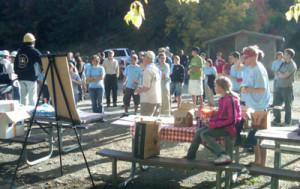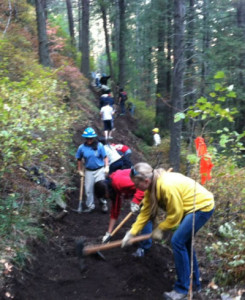By Cheryl Probert for EDR Blog.org
Partnerships and collaboration seem to be all the rage in public land management. But do the feds truly understand what collaboration is or how to set up a sustainable partnership? Having recently muddled through setting up and trying to sustain a collaborative partnership on public lands, I would say that we make three fundamental mistakes when we embark on the collaborative path:
- Often, federal managers approach collaboration as beefed-up public involvement.
- We also approach public-private partnerships as a way to fund our previously planned projects.
- And finally, we make a big financial investment to set up a partnership or start a collaborative but we do not plan for the resources needed to keep those partnerships moving.
So why do we keep trying and how do we become more successful? Public land managers are facing a crisis and we need help. We have more resource issues to deal with than we have money to fix or manage. As our budgets continue to decline we are looking to the private sector to tap into the resources of those who benefit from and care about the lands we manage. We also need to build social capacity and understanding for the things we do. We need to help an increasingly urban society figure out why they should care about public land management and sustainability. We need to bring our stakeholders together for common goals rather than be stuck in the middle of polarized groups. But let’s face it, we are bureaucrats who are skilled in managing natural resources. We are not skilled in the arenas of soliciting funds and collaborating with partners. Our regulations direct us to manage the land according to the laws of science and regulation, and those constraints do not always coincide with the desires of our collaborators.

If collaboration and partnerships are important, indeed critical, to our ability to care for the land, how do we become more successful over the long haul?
Two years ago my Forest, the Uinta-Wasatch-Cache teamed up with Salt Lake City and formed a public-private collaborative with the common vision of providing economically and ecologically sustainable recreation while maintaining and improving water quality in the mountains adjacent to Salt Lake City. The Wasatch Legacy Project (WLP), as we are now known, is made up of state, federal, and municipal governments as well as user groups and industry, with an interest in managing the watersheds feeding into Salt Lake City. We have been moderately successful—accomplishing some projects and getting money from a few partners to do work on federal, private, and city owned lands. After two years, the WLP is borne on the backs of a few and we are partnering on a site-by-site, trail-by-trail basis. We continue to struggle with time constraints of partners; we aren’t hooking the big corporate donors; and we are still moving in fits and starts. There are meetings where I can barely contain my sense of déjà vu. There are meetings where I come away thinking all we have accomplished is to complicate a steel ball. Yet I keep coming back; we keep coming back. Why? I think first and foremost we believe in the Vision and it’s a vision we cannot achieve separately. It’s a vision that can only be turned into reality through collaboration.
 So what are some components of a successful, long-term collaboration? Here are a few things to think about before accepting an invitation to collaborate:
So what are some components of a successful, long-term collaboration? Here are a few things to think about before accepting an invitation to collaborate:
- Collaboration is about relinquishing control of the process, the players, and the outcomes. If we want to be successful, and truly collaborate with stakeholders, we need to let go. We should pick the issues or areas that we collaborate on carefully and make sure that we really can let go of the outcomes. If we cannot, if our regulations do not allow us to, then collaboration is not the right tool for the job.
- If we do decide to collaborate, we need to be committed to listening and learning. We need to be open to changing priorities and changing outcomes. Too often we think we know the answers. I’ve found that while stakeholders often look to the agencies for expertise in land management issues, they do not want us to tell them how it must be done. We cannot drive the process, the projects, and the priorities. We are experts in the physical and biological sciences but to collaborate one must understand social science as well. I think that part of the reason the Forest Service has become less relevant to people is that we do not focus on priorities of our stakeholders. We focus on priorities of the land, but that is only one half of our Mission of “Caring for the land, serving the people.” We need to listen, and learn from the people we serve.
- Collaboration needs a champion, a person or persons with energy, drive, enthusiasm, creativity and endurance. When we first dive into a collaborative effort, we are excited, we have resources (people, time and money) and we accomplish a lot. We eagerly sign agreements, develop governance documents, produce a communication strategy, and start on projects. That’s all we need, right? In the case of the WLP, that has not been enough to keep us going. We geared up for a collaborative effort, hired a consultant to help us organize and developed a vision, goals, and actions. We signed some documents, developed some plans and turned some dirt. Then we all went back to our day jobs… and the partnership stalled.
- I have discovered that we need to stay engaged, stay at the table, and keep the resources flowing. Someone needs to be the engine of the collaborative machine. As the interest of other partners ebbs and flows, that engine is always there, moving the collaborative forward.
- Finally, the success of a collaborative effort is based on relationships and relationships take time and resources to maintain. Whether you are the engine described above, or not, you need to have relationships with all the partners. Before you embark on this journey, plan for this time at the outset and over the long-term.
The road to successful collaboration is littered with stalled partnerships and coalitions. But if we choose the right vehicle (project), have a common vision for where we want to go, and keep the engine running, we will get there. We just need to be conscious of the energy it will take to travel the entire length of the journey.
Cheryl Probert is currently the Deputy Forest Supervisor on the Uinta-Wasatch-Cache National Forest in northern Utah. Cheryl has spent over 25 years working for the USDA Forest Service in various capacities around the west including rangeland management specialist, wildlife biologist, environmental coordinator, forest planner, District Ranger and Forest Supervisor.
